Legislation
PLT and the Law

And oh boy is it an ass. . .
In previous pages we looked at some of the effects of PLT, the potential of the technology to cause interference both now and in the future and touched upon the dirty world of legislation. On this page we will take a look at some of the hard figures which has set some interested parties into a frenzy and illustrate why PLT should be of concern, not just to radio users and enthusiasts but to the population at-large.
Every piece of electronic equipment we buy, whether an iPod, phone, hair dryer, kettle, TV and everything else besides requires that faithful old "CE" mark if you want to sell it in anywhere in the European Union. There are a plethora of standards, documents, red tape and "other things" we need not concern ourselves with but which are required in order to be able to peddle your wares in Europe. The one aspect we do want to concern ourselves with, is EMC.
What is EMC? A short history lesson.
EMC is short for Electromagnetic Compatibility:
the ability of equipment or a system to function satisfactorily in its electromagnetic environment, when used as intended:
- without causing intolerable electromagnetic interference (EMI) into its environment, and,
- without suffering unacceptable degradation of performance due to EMI present in its operating environment.
In other words it shouldn't cause interference or be affected by interference.
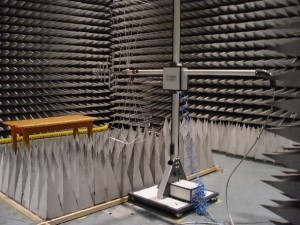
The subject of EMC first appeared in any significance in the 1950s, after the rocketing popularity of the "wireless" i.e. radio. With stations interfering with each other both intentionally and otherwise the federal government of the USA decided that regulation was needed. Also in the 1950s, technology moved forward a stage with the deployment of the transistor and militaries everywhere began the arms race of electronic warfare.
With a host of new, powerful equipment coming into service, it soon became apparent that an unintended consequence of having some equipment in proximity to others was having a negative effect on performance. EMC was born. Moving forward a few decades to the 1980s, a sudden population explosion of a device known as the personal computer came about.
With little regard for consequence, equipment was deployed and printers, mice, keyboards and a host of peripherals all needed interconnecting cables, almost all of which radiated some form of interference. If you are under about thirty, ask your mum or dad what happened to their car radio when they drove though the High Street. Quickly the European Union sought to regain control of the interference before it became a serious threat to services which relied upon radio and thus the EMC Directive was born. Enacted in 1989 under 89/336/EEC, it took measures to ensure that unintentional interference between electrical and electronic devices would come to an end.
For those who do not understand the mechanism, simply stated, an EU Directive must be translated into the laws of the member states of the European Union. In our case in the UK, this was Statutory Instrument SI3418. More recently a new EMC Directive (2004/108/EC) has translated into the UK's Electromagnetic Compatibility Regulations 2006.
EMC Law is complex and interconnects with other legislation, for example the "wiring regs" used by electricians (BS7671) will have an EMC 'Annexe' legally applicable from 2011.
Our apologies for the history lesson but it has served to set the stage for what follows. So now you know the first bits of jargon; EMC and the EMC Directive. This is where the story begins.
For electrical and electronic products to obtain CE certification they MUST (mandatory) comply with the EMC Directive. To this end, a team of electronics experts through a combination of calculation, experience and trial and error came up with limits for interference and the accepted means for making the appropriate measurements. These limits are electrical measurements for the strength of unwanted interference and come in two flavours; conducted - interference travelling along a cable; and radiated - travelling through the air as radio waves.
The limits have the acronym CISPR[i] and in particular CISPR 22 and have been carefully amended over time in the light of better understanding and more accurate instrumentation.
Two routes exist for CE certification, one requires a sample of the product to be submitted to recognised laboratories (Notified Body) who conduct the suite of tests required for the product type, the results collated and subject to the levels falling within the CISPR limits, the manufacturer then uses this as the basis for their declaration of conformity.
If the product fails to meet the required limits for conducted and radiated emissions, the manufacturer is required to make the necessary modifications and resubmit for test.
For reasons beyond the scope of this website, a second route existed prior to the 2004 EMC Directive becoming enforceable. This was called the Technical Construction File (TCF). Put simply, this allowed the manufacturer to cite technical documentation as evidence of compliance. Since the documentation can be verified by persons with suitable expertise, it provided an alternative to manufacturers, who, for whatever reason, did not want to engage in physical testing and certification.
Needless to say this has been chronically abused since most customs officers have no understanding of the technical documentation and most often the regulators do not become involved unless a specific complaint or allegation is made.
Enter PLT...
In a moment you will see some graphics which represent the CISPR limits and where the PLT measurements fall on this scale. The most important aspect of the PLT ‘situation’ sits squarely with the emissions and the limits. The manufacturers of PLT equipment already know that their equipment cannot succeed via the physical testing route. All tests to date conducted by independent entities on PLT equipment confirm that the devices’ emissions are horrendously above the prescribed limits. Knowing this the manufacturers use the TCF route to obtain type approval.
What is quite astounding is that the same manufacturers had the audacity to think that everyone else is stupid and did not understand the documentation. Regretfully they were right – at least partly. They were correct long enough to establish a foothold in the markets and having duped the authorities then continued from a position of power.
The declaration used for type approval referenced CISPR/I/89/CD to establish that the limits were within acceptable tolerance. The problem with this is that "CD" stands for "Committee Draft" and the document referenced was widely criticised and acrimoniously removed from the IEC’s website in 2003. To this day it remains a completely discredited and worthless document. Nonetheless this is the basis for the PLT equipment obtaining CE certification and being allowed to be sold on the open market.
On the HomePlug Powerline Alliance website, careful browsing allows one to locate a PDF which is a presentation entitled,
HomePlug Executive Seminar, Setting Standards In Motion
![]()
Page four of this document is titled: EMC Issue with EN 55022
and the HPA categorically state: ".....so failed the test and we could not generate (directly) the DoC (Declaration of Conformity) needed for Europe."
In the words of the HomePlug Powerline Alliance themselves, the products do not comply with EN 55022...
With the new 2004 EMC Directive coming into force, with important aspects of the directive’s documentation becoming mandatory in July 2009 (2006 edition EN55022), the ‘edition’ was due to contain a graphic ‘decision tree’ which made it much easier for less technically minded persons to understand the limits and mechanisms. This graphic would have shown the PLT technology for what it is. Good news? Not really. The PLT consortium managed to obtain a stay of execution on this element of the CISPR documentation until 2011 giving them enough time to ‘dig in’.
While you digest the indigestible, we will move on to pretty pictures for light relief.
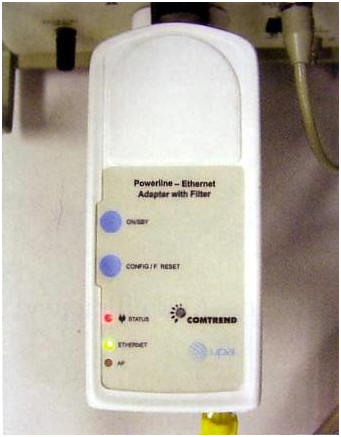 |
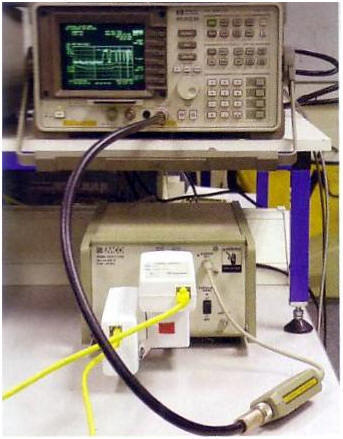 |
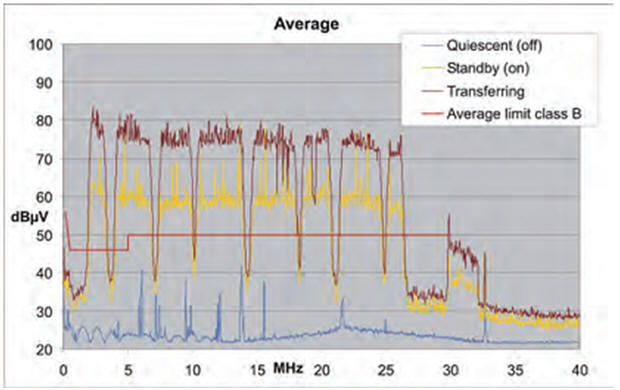
Compliance Test result of the Comtrend PLT adapter supplied by British Telecom [ii] |
|
Fortunately it is not too technical. The horizontal axis is calibrated in Frequency (MHz) and represents what has become known as the "Shortwave" band. The vertical axis is calibrated in electrical strength (micro-volts) using the decibel scale. You will see that the trace looks much like your bottom teeth and is characterised by a series of flat-top peaks and sharp nulls.
What is particularly important about this trace is the current legal limit which is represented by the red line which remains mostly horizontal. What is striking about this measurement is that even at the lowest signal level measured, the results are only just below the legal limit lines.
If you recall, we mentioned that when the standard was proposed, the Amateur Bands were "notched" out. These are represented by the downward pointing ‘spikes’ of the trace and are the only elements of these which barely reach the limit set in European law. The peaks however are another thing altogether to behold!
Put in layman’s terms, the peaks are approximately 30dB above the limits, which translates to one device with these measurements creating the same amount of interference as – wait for it – 1,000 barely legal devices, all plugged into the same socket and operating. Another analogy places this as one house creating the same interference as a small town. That puts it in perspective when you think that the estimated population of these devices were 423,000 as at April 2009 (Estimated at 750,000 by Ofcom's latest PLT statement).
Now on to the next pretty picture! Do you remember the term intermodulation? We will call it "Intermod" for short. It is the result of an electrical process which occurs in passive semiconductor devices like diodes which are found in many common household mains powered devices (this includes some "transformers" (adapters/power-supplies) for low power devices).
This modifies the hundreds of individual channel signals generated by PLT and results in greater interference:-
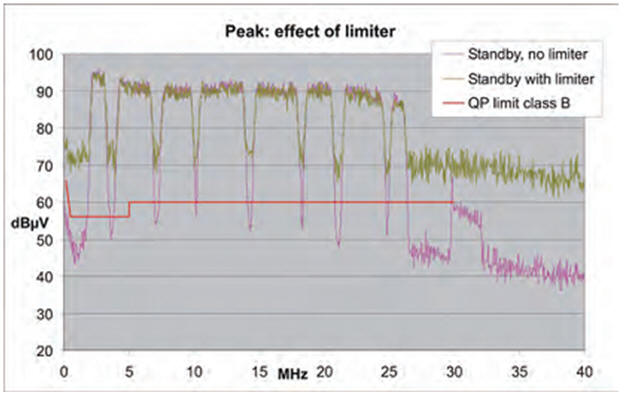
Compliance Test result of the Comtrend PLT adapter supplied by British Telecom [iii]
The same graph scale now looks quite different from the first. The most notable features are that the peaks have increased by around 10dB (this is another ten times the interference) and the lowest readings fail to make it anywhere near the legal limit. The graph is not perfectly clear so to confirm, the purple trace represents the Comtrend in standby, without an "intermod" device present. The tan colour represents the same unit in standby but with the "intermod" device present in circuit. This could simply be your TV or kitchen radio, for example.
The effect from a radio user’s point of view is complete disaster.
At this point you are probably wondering why Ofcom have not intervened and taken enforcement action to have the equipment withdrawn from the market? Frankly the ‘EMC world’ is thinking the same. More questions than answers exist at this point in time.
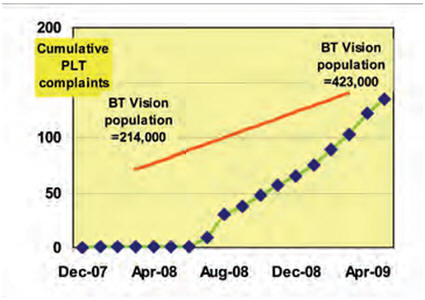
Graph of the growth of BT Vision subscribers and PLT complaints [iv]
As can be seen by this graph, complaints about PLT were pretty much non-existent before the 2nd quarter of 2008. This is because prior to that point, very few people knew how to complain. It is fair to say that most people did not even know they could complain and if so, to whom?
That changed with the launch of UKQRM. Mike Trodd, a Shortwave listener, had simply had enough of the noise and set about raising the profile of the problem and UKQRM was born. From here, Mike then launched a number of YouTube videos and filled in the void of the "who do I complain to?" question. Once users of SW knew that not only could they complain but there was a duty by Ofcom to investigate the problem, the level of complaints rocketed almost over night. Now PLT is the top dog on the list of interference causes investigated by Ofcom’s interference team.
PLT and the Wireless Telegraphy Act
A bit of history
In Britain prior to 1922, the General Post Office (GPO) retained exclusive rights given to it by government, to manage and control all means of mass communication with the exception of the printed word for which authority had devolved to another governmental entity. The laws which evolved into the Wireless Telegraphy Act 1947, upon which all modern British communication laws are built in one way or another, concern four essential activities: the establishment of a station for purposes of broadcasting; the use of a station for purposes of broadcasting; the installing of a transmitter at a station, and the use of a transmitter at a station. All four of these activities require a government licence which was originally granted by the General Post Office.
There have been many amendments to the act over the years to keep abreast of changing technologies whilst keeping to the fundamental foundations.
The current act on statute is the Wireless Telegraphy Act 2006.
Our reading of the act
It is our belief that PLT breaches the Wireless Telegraphy Act by its use of the mains wiring for a purpose for which it was not intended.
Section 116 of the Act states:
116 "Wireless telegraphy"
(1) In this Act "wireless telegraphy" means the emitting or receiving, over paths that are not provided by any material substance constructed or arranged for the purpose, of energy to which subsection (2) applies.
(2) This subsection applies to electromagnetic energy of a frequency not exceeding 3,000 gigahertz that—
(a) serves for conveying messages, sound or visual images (whether or not the messages, sound or images are actually received by anyone), or for operating or controlling machinery or apparatus; or
(b) is used in connection with determining position, bearing or distance, or for gaining information as to the presence, absence, position or motion of an object or of a class of objects.
(3) The Secretary of State may by order modify the definition of "wireless telegraphy" by substituting a different frequency for the frequency that is for the time being specified in subsection (2).
(4) No order is to be made containing provision authorised by subsection (3) unless a draft of the order has been laid before Parliament and approved by a resolution of each House.
Section 117 of the Act states:
117 "Wireless telegraphy apparatus" and "wireless telegraphy station"
(1) In this Act "wireless telegraphy apparatus" means apparatus for the emitting or receiving, over paths that are not provided by any material substance constructed or arranged for the purpose, of energy to which section 116(2) applies.
(2) In this Act “wireless telegraphy station”—
(a) means a station for the emitting or receiving, over paths that are not provided by any material substance constructed or arranged for the purpose, of energy to which section 116(2) applies; and
(b) includes the wireless telegraphy apparatus of a ship or aircraft.
Ofcom's position
When a member of the pressure group UKQRM suggested to the UK's national regulator Ofcom that "paths that are not provided by any material substance constructed or arranged for the purpose" meant PLT should not be using the mains for radio frequency energy, their response was: "Seek your own legal advice."
We thought that was the job of a national government organisation?! If they do not know the answer, how is the rest of society to know where they legally stand?
Are you a legal-eagle? What is your take on this section of the WTA? We would love to hear from you!
In conclusion
There is a wealth of evidence available which scientifically validates the position that PLT is non-compliant with current legislation. YouTube is filled with evidence that deployed PLT causes significant disruption to the entire HF spectrum (SW) and that a single installation has been observed causing sufficient interference to be disruptive at over 1.2km from the source.
The technical documentation used to obtain CE type approval is not worth the paper it would be written on (if it actually existed).
The Swedish administration has made a decision for withdrawal from the market of some power line communication equipment which was declared in conformity
with the EMC Directive based on EN55022:1998. The Swedish authorities felt that the equipment did not comply with the protection requirements of the EMC Directive.
![]()
Under the terms of the Communication Act 2003(c21), Ofcom have Statutory Duties to:-
(2) The things which, by virtue of subsection (1), OFCOM are required to secure in the carrying out of their functions include, in particular, each of the following—
(a) the optimal use for wireless telegraphy of the electro-magnetic spectrum;
 15. Duty to publish and take account of research
15. Duty to publish and take account of research
 154. Duties of OFCOM when carrying out spectrum functions
154. Duties of OFCOM when carrying out spectrum functions
(1) It shall be the duty of OFCOM, in carrying out their functions under the enactments relating to the management of the radio spectrum, to have regard, in particular, to—
(a) the extent to which the electro-magnetic spectrum is available for use, or further use, for wireless telegraphy;
(b) the demand for use of that spectrum for wireless telegraphy; and
(c) the demand that is likely to arise in future for the use of that spectrum for wireless telegraphy.
(2) It shall also be their duty, in carrying out their functions under those enactments to have regard, in particular, to the desirability of promoting—
(a) the efficient management and use of the part of the electro-magnetic spectrum available for wireless telegraphy;
From the above snips of the CA2003 it becomes clear that Ofcom have not been taking their responsibilities seriously. Since they have commissioned a report into the technology this raises some hope that the Regulator of communications in the UK may take some responsibility for their error in judgement.
Irrespective of the complex law governing EMC, it can be boiled down to the EMC Directive’s "Essential Requirement", Article 5 which supersedes everything else:
"Equipment shall be so designed and manufactured, having regard to the state of the art, as to ensure that:
(a) the electromagnetic disturbance generated does not exceed the level above which radio and telecommunications equipment or other equipment cannot operate as intended;
(b) it has a level of immunity to the electromagnetic disturbance to be expected in its intended use which allows it to operate without unacceptable degradation of its intended use."
Article 10(1) of the EMC Directive, something which Ofcom keeps quiet about, tells us that:
"Where a member state ascertains that apparatus bearing the CE mark does not comply with the requirements of this Directive [the "essential requirements"] it shall take all appropriate measures to withdraw the apparatus from the market, to prohibit its placing on the market or the putting into service, or to restrict its free movement thereof."
As such from the evidence available in the public domain, PLT equipment currently deployed is not lawful under European legislation and consequently by translation of the Directive into
UK law with the EMC Regulations 2006
![]() this technology is not lawful in the UK.
this technology is not lawful in the UK.
Ofcom have a Statutory Duty to enforce the law. But instead they cower behind the banal statement that "there isn’t a problem because the number of complaints is relatively low".
If you care to follow the links on the Freedom of Information page, you can see how far we have got in extracting the correct information out of Ofcom.
Finally we leave you with this quote by Jonathon Stott, BBC Research and Development, 2006;
"Radio services are entitled to protection from interference under the terms of the International Radio Regulations and the European EMC Directive. […]
The radio spectrum below 30 MHz is a unique resource of special value to radio users because of its long-distance propagation properties which, in the case of broadcasting,
are essential to international broadcasters and are also of very great value for national broadcasting where countries are large, poor, have scattered populations or are in the Tropics.
Proposals by Administrations or the European Commission for the regulation of emissions do not adequately protect broadcasting. In one case the gulf is of the order of 60 dB.
Proposals like this just bring EMC regulation into disrepute.
What is needed is for interference to be prevented. It appears that this can only be achieved if PLT does not operate at the same time, at the same frequency and in the same
place as broadcast reception is taking place. ‘Notching’ of the PLT system is proposed as the way to achieve this.
Notching alone is not enough. It has to be verified that sufficiently deep notches can be achieved. They have to be flexibly allocated whenever and wherever needed.
A human system for doing this would be costly, slow to respond to need and would raise difficult ethical questions over censorship."
[v]
References
[ii] RF Emissions of Powerline Ethernet adapters, Tim Williams – The EMC Journal – Issue 82, May 2009
[iii] RF Emissions of Powerline Ethernet adapters, Tim Williams – The EMC Journal – Issue 82, May 2009
[iv] BT Vision; the radio interference iceberg – Richard Marshall MA, CEng. FIEE, FInstP, FIET, The EMC Journal – July 2009
[v] PLT and broadcasting – can they co-exist?
![]() Jonathon Scott, BBC New Media & Technology
Jonathon Scott, BBC New Media & Technology
Page updated: 15th August 2021
Home
|
News
|
What is PLT?
|
Why the fuss?
|
What can I do?
|
Shame on you!
|
Videos
|
EMC Tests
|
EMCIA
EN55022
|
prEN50561-1:2012
|
Legislation
|
Truth & Lies
|
Adjournment Debate
Guest author DJ5IL: The Trojan Horse of the PLC-Lobby: FprEN50561-1
|
Doomed to Fail: FprEN50561-1